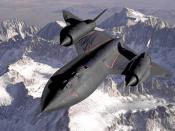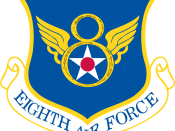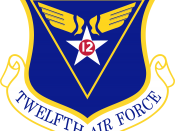The Cold War and Its Effects on Airpower Theory Airpower theory prior to and during World War II relied on maintaining the offensive, developing a long range bomber force, and ensuring institutional independence for a separate air force. The Soviet threat, however, dictated the evolution of airpower theory during the Cold War. Following the delivery of the first atomic weapons at the end of World War II, the United States shifted towards a military strategy of nuclear deterrence in response to the emergence of the Soviet Union as a political and military force. This strategy became the centerpiece for all weapons and tactics development, ultimately at the expense of the more "traditional"ÃÂ roles of strategic bombing and close air support of ground forces. Although these views radically modified the American airman's perspective of warfare, they did not represent a demise in "classical"ÃÂ airpower theory.
First, let's examine the question of the offensive.
Did the Cold War continue the concentration of efforts toward maintaining an offensive posture via the use of airpower? Most theorists validated the atomic bomb as the ultimate offensive weapon in the American arsenal, and rightly so. Although not directly involved in the development and production of the weapon, airmen quickly came to understand its offensive and destructive capabilities. A new idea emerged, however, as a result of this new technology"ÃÂdeterrence. The Air Force not only had to concern itself with delivering nuclear weapons, but also protecting the United States from enemy attack. The Cold War therefore represented the first real introduction of defensive considerations into airpower theory. It is important to understand, however, that this did not diminish the importance of the offensive because the only way to present a credible atomic threat was to maintain the capability to smash the enemy at any time.
The long range bomber was paramount to the success of both the nuclear offensive and a deterrent strategy. To many airpower theorists, the end of World War II and the delivery of the atomic bombs strengthened their views that strategic bombardment was the critical element in warfare. The subsequent concentration on deterrence advanced these opinions even further. To develop a realistic and credible nuclear threat, the Air Force stressed the importance of an alert force of long range bombers capable of delivering atomic weapons at a moment's notice. Strategic Air Command (SAC) became the premiere Air Force organization.
Although leaders tended to stress the importance of the nuclear role in the Cold War environment, the bomber's conventional role was not completely overlooked. The Spaatz Board realized air superiority and suppression of enemy air defenses were critical elements for any strategic bombing campaign. This was especially true because of the limited numbers of atomic weapons, nuclear-modified B-29 aircraft, and trained aircrews. Conventional bombardment was therefore still crucial to the success of the nuclear campaign, and ensured the continued importance of the long-range bomber throughout the period of the Cold War.
The third pillar of "classical"ÃÂ airpower theory was the institutional independence of a separate air force. In September 1947, the United States Air Force was officially formed, marking the realization of the vision of early advocates such as William "Billy"ÃÂ Mitchell. The Air Force quickly began work on post-World War II doctrine, stressing the unique role of airpower in a nuclear conflict. They felt that only the Air Force could effectively pose the necessary long range threat to the enemy, while maintaining the ability to protect America from foreign attack. In other words, the Air Force represented the critical component of this new deterrent strategy.
While the new Air Force exemplified and practiced the three precepts of "classical"ÃÂ airpower theory, the future conflict in Vietnam necessitated a doctrinal shift that neither the Air Force nor American political leaders were prepared to make. Developments there did not call for the demise of "classical"ÃÂ theory, only a modification in three key areas"ÃÂthe significance of tactical aviation, the importance of the defensive, and the Air Force's role in joint doctrine. The United States instead used the Cold War to emphasize technological advances and a quantitative advantage of weapons systems, much as it had during World War II. This prominence of technology and numbers did not translate well to the Vietnam conflict, leading to a poorly conducted air campaign.
The first mistake made by military and political leaders was the notion that all adversaries are created equal. Preparations for war in Korea or Vietnam did not require the same tactics or employment methods as a potential nuclear crisis against the Soviet Union, but this was not readily apparent to America's leaders. The style of warfare in Southeast Asia was of a limited nature, not one of massive retaliation and mutually assured destruction. Instead of planning for nuclear bombardment of strategic centers of gravity deep within enemy territory, the Air Force found itself prosecuting a mostly tactical campaign in support of the ground forces. There were also very limited numbers of key industrial targets to justify a prolonged strategic bombing campaign. Most air assets were therefore flexed to interdiction, close air support, and air superiority roles. Although theorists stressed the importance of air superiority for years, American fighters of the Vietnam era, such as the F-100 and F-105, were ill-equipped for air-to-air combat due to their design specifications for high-speed delivery of nuclear weapons and lack of well-developed air-to-air tactics. This resulted in low aerial combat success rates against North Vietnamese MiGs.
The root cause of these failure can be traced to the predominance of SAC at the expense of the Tactical Air Command (TAC). In 1948, TAC was relegated to a headquarters status under Continental Air Command, rather than the command status necessary to remain a viable fighting force. The only reason it survived at all during this era was the need to maintain cursory coordination with the Army and Navy. The single-minded notion that airpower should concentrate on all-out nuclear conflict handcuffed the Air Force into training for the wrong kind of war. Leaders failed to learn the lessons of World War II regarding the success of tactical missions that significantly enhanced the ground and naval efforts. As Dr. Williamson Murray states, "The performance of the USAF"æin North and South Vietnam reflected the inapplicability of tactics and doctrine, largely developed in response to the Soviet threat."àAs a result of experiences in Vietnam and Korea, tactical aviation regained an important role in the Air Force, and would eventually become the dominant component of the service, with fighter aircraft assuming such varied roles as counterair, interdiction, close air support, suppression of enemy air defenses, and strategic attack. This was not, however, at the expense of the bomber force. The Air Force continues to rely on manned bombers as an important contributor to the deterrent strategy, and will do so as long as there are weapons of mass destruction available to the adversary. This shift in focus from bombers to fighters did not signal the demise of "classical"àairpower theory because the bomber remains an extremely important combat delivery platform, especially in today's air expeditionary force environment.
American leaders in Vietnam made a second critical mistake when they overlooked the importance of the defensive in air operations, especially in a conflict such as the Vietnam War. The Soviet Union supplied North Vietnam with vast amounts of surface-to-air missiles and anti-aircraft artillery, most of which the Air Force was unprepared to counter. American aircraft carried no electronic countermeasures equipment, increasing loss rates that were already high due to air-to-air losses"ÃÂan interesting fact considering the American reliance on technology and weapons development in the aftermath of World War II. During Operation ROLLING THUNDER alone, North Vietnamese air defenses shot down 922 American aircraft. The combination of a lack of sound tactical training and the absence of on-board defensive systems magnified the Air Force's problems in Vietnam.
The Vietnam War identified the importance of defensive measures in combat, but in no way discounted the criticality of the offensive. Without an offensive capability, air forces are paralyzed and in no position to assist a campaign effort. Since Vietnam, the Air Force has equipped most all aircraft with radar warning receivers and countermeasures dispensers. These systems are critical for aircrew and aircraft survivability. But the bottom line is these defensive systems improve the capabilities of these aircraft to perform their primary offensive roles. In other words, there is a synergy that results from the incorporation of the two, thus enhancing the offensive precept of "classical"ÃÂ airpower theory.
A third contributing factor to the lack of success in Vietnam was the misunderstanding of the importance of joint doctrine, especially on the tactical level. The advances General Elwood Quesada made regarding close air support during World War II were overshadowed by the postwar concentration on strategic nuclear deterrence. Unfortunately, military leaders did not foresee that future conflicts would occur in countries lacking a modern industrial infrastructure and equipped with a relatively robust air defense system. Armed with that knowledge, they might have been able to more readily identify the potential deficiencies with a strategic bombing campaign and place more emphasis on working with the Army and Navy to conduct effective tactical operations.
The Vietnam War reiterated the lessons learned in World War II regarding the importance of tactical airpower and interservice cooperation. This, however, did not detract from the necessity of an independent Air Force. It was important, and remains so today, to have a service whose expertise lies in the employment of air power. It is equally important though, to ensure air assets are used in a way that benefits all services through the application of effective joint doctrine. Political and military leaders made great strides to correct this oversight during Operation DESERT STORM by identifying the need for a Joint Forces Air Component Commander. This was a foreign concept to leaders during the Vietnam War. Instead, the Air Force was unprepared for the multifaceted role of airpower employed over a wide variety of missions, but primarily reflecting the needs of ground forces. As Robert Futrell states, "The emphasis was in making war fit the weapon"æit was a weapons strategy wherein the weapons determined the strategy rather than the strategy determining the weapons."àThe Cold War reshaped airpower theory by introducing the concept of deterrence and stressing the role of technology, causing military leaders to reexamine airpower roles and their relation to achieving strategic objectives. This focus reiterated the precepts of "classical"àairpower theory by stressing the offensive capability of the bomber in the newly-independent Air Force. The Vietnam War, however, challenged this theory by reemphasizing concepts such as close air support, defensive protection, and joint doctrine. These concepts did not signal the demise of "classical"àtheory, but instead redefined the way we turned the theory into doctrine. The ability to maintain the offensive, the importance of the long range bomber, and the need for an independent air force were as relevant following the Vietnam War as they were in the days of General Mitchell, and even today. Vietnam taught military leaders valuable lessons in never underestimating the significance of tactical aviation, the defensive, and joint doctrine"ÃÂlessons we have since put to use in DESERT STORM and ALLIED FORCE.


